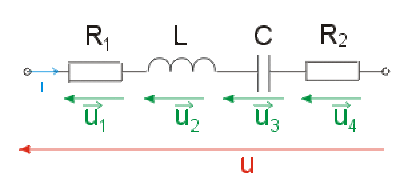Dipôle RLC
Durée : 4 mn
Note maximale : 3
Question
\(R_1 = 100 \mathrm{ } \Omega\) ; \(R_2 = 100 \mathrm{ } \Omega\) ; \(L = \mathrm{0,9 H}\) ; \(C = 1 \mathrm{ \mu F}\) ; \(\omega = 10^3 \mathrm{ rad/s}\)
Donner l'expression de l'impédance complexe \(\underline{Z}\) du circuit sous la forme : \(\underline{Z} = R + j.X\)
Quel nom portent respectivement \(R\) et \(X\) ?
Donner la valeur numérique de \(\underline{Z}\).

Solution
\(\displaystyle{ \underline{Z}=(R_1+R_2) + j . \left(L \omega - \frac{1}{C \omega} \right) = R + j . X }\) (1 pt)
\(R\) est la résistance du circuit.
\(X\) est la réactance du circuit. (1 pt)
\(\underline{Z} = (200 - j . 100) \mathrm{ } \Omega\) (1 pt)